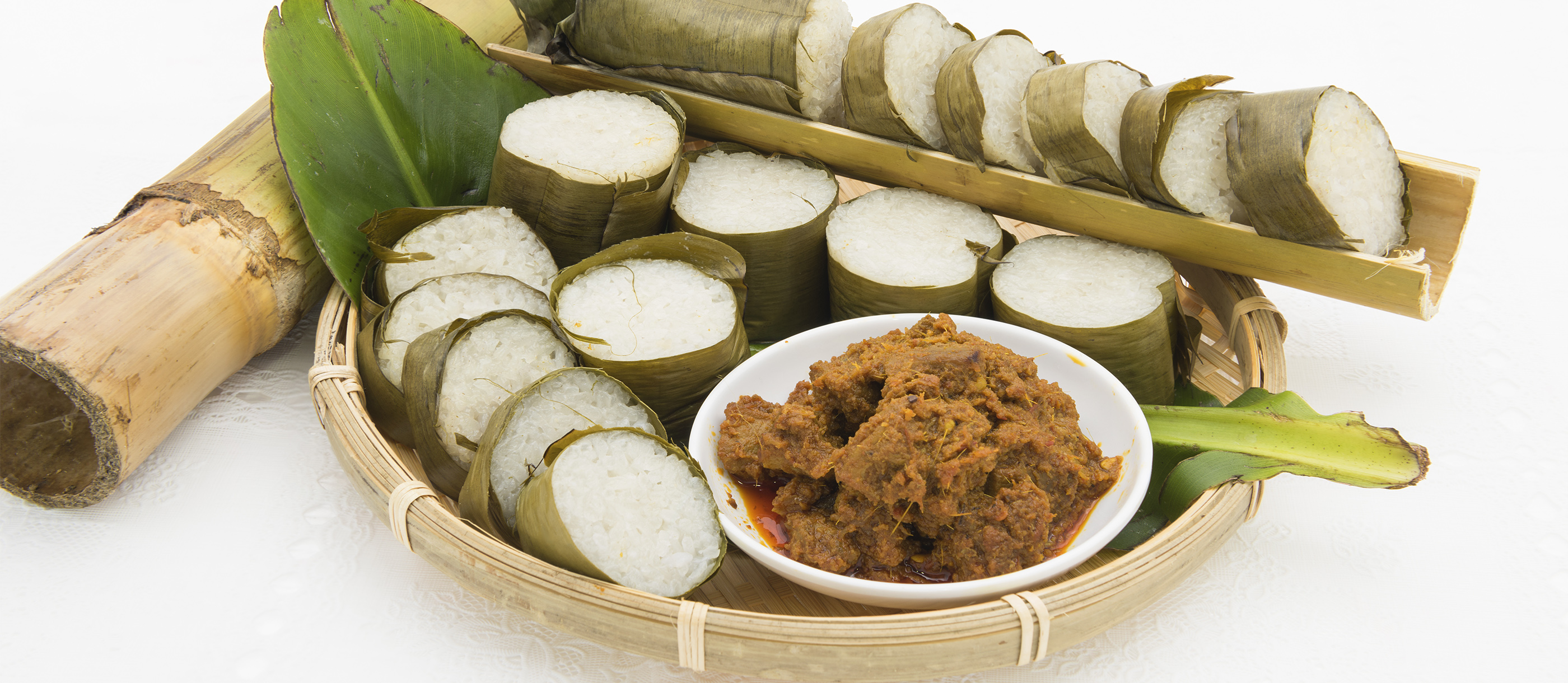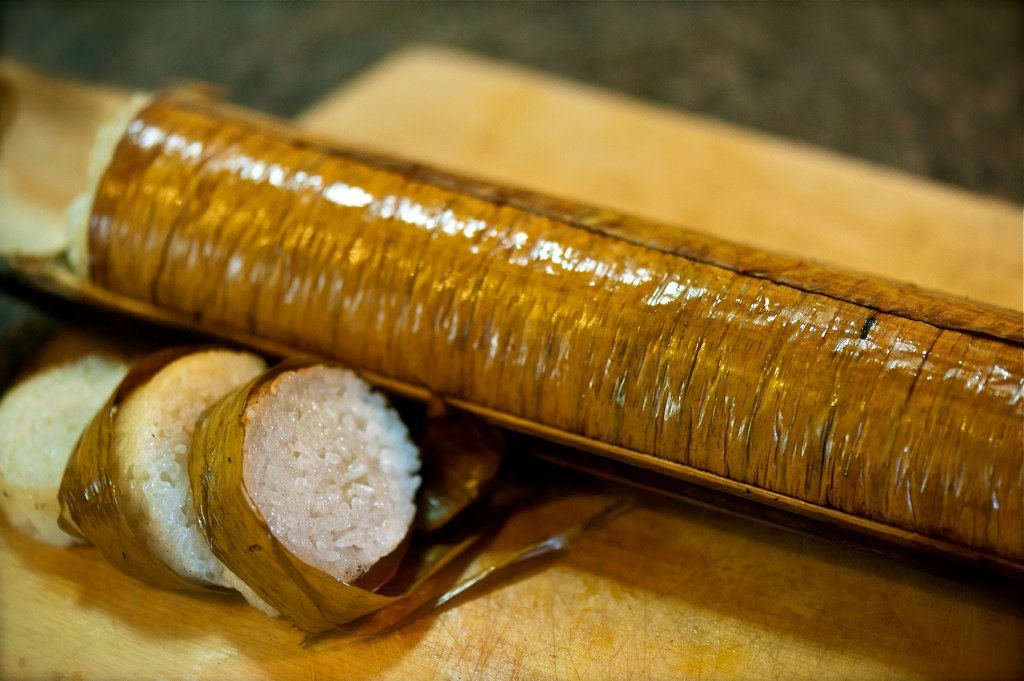Embark on a culinary adventure to the heart of Southeast Asia with nasi lemang, a delectable dish that captures the essence of tradition and flavors. This aromatic glutinous rice dish, cooked within bamboo stalks, has tantalized taste buds for centuries, holding a special place in the cultural fabric of the region.
From its humble origins to its diverse variations, let’s delve into the world of nasi lemang, uncovering its secrets and exploring its cultural significance.
In this comprehensive guide, we will provide a detailed recipe for making authentic nasi lemang, exploring the nuances of its ingredients, cooking methods, and serving suggestions. We will also delve into the cultural significance of this dish, understanding its role in festivals, ceremonies, and everyday life.
Join us on this culinary journey as we uncover the secrets of nasi lemang, a dish that embodies the rich tapestry of Southeast Asian cuisine.
Ingredients
Nasi lemang is a traditional Malay dish made from glutinous rice cooked in coconut milk and bamboo. The ingredients used in nasi lemang are essential for creating its unique flavor and texture.
The following is a detailed list of ingredients required for making nasi lemang, along with their specific measurements and descriptions:
Glutinous Rice
- 2 cups glutinous rice, soaked overnight
Glutinous rice is the main ingredient in nasi lemang. It is a type of rice that is sticky when cooked, which gives nasi lemang its characteristic texture.
Coconut Milk
- 2 cups coconut milk
Coconut milk is used to add flavor and richness to nasi lemang. It also helps to keep the rice moist and prevents it from becoming dry.
Salt
- 1 teaspoon salt
Salt is used to enhance the flavor of nasi lemang. It helps to balance out the sweetness of the coconut milk and the glutinous rice.
Bamboo
- 4 bamboo tubes, cut into 12-inch lengths
Bamboo is used to cook nasi lemang. The bamboo tubes provide a natural container for the rice and help to infuse it with a smoky flavor.
Cooking Method
Nasi lemang is traditionally cooked using a bamboo stalk as the cooking vessel. The bamboo is first lined with banana leaves to prevent the rice from sticking, and then filled with a mixture of glutinous rice, coconut milk, and salt.
The bamboo is then sealed with more banana leaves and placed over a fire.
The fire slowly cooks the rice, and the smoke from the fire imparts a unique flavor to the dish. The rice is cooked for several hours, until it is tender and fluffy. Once cooked, the bamboo is split open and the nasi lemang is served with a variety of side dishes.
Tips for Achieving the Perfect Texture and Aroma
- Use high-quality glutinous rice. This type of rice is sticky and will help to create the desired texture for nasi lemang.
- Use fresh coconut milk. The coconut milk will add a rich flavor to the dish.
- Season the rice with salt to taste. The salt will help to balance the sweetness of the coconut milk.
- Cook the rice over a low fire. This will help to prevent the rice from burning.
- Cook the rice for several hours. This will allow the rice to fully cook and develop a rich flavor.
Variations
Nasi lemang exhibits regional variations across different parts of Indonesia and Malaysia. These variations stem from cultural influences, availability of ingredients, and traditional cooking practices.
Nasi Lemang Pulut Hitam
Nasi lemang pulut hitam incorporates black glutinous rice, giving it a distinctive black color and slightly nutty flavor. This variation is popular in the Malaysian state of Negeri Sembilan.
Nasi Lemang Kukus
Nasi lemang kukus is a steamed version of nasi lemang. It is typically cooked in a steamer or a pressure cooker, resulting in a moist and fluffy texture. This variation is commonly found in the Indonesian region of Sumatra.
Nasi Lemang Daun Pisang
Nasi lemang daun pisang is wrapped in banana leaves before cooking. The banana leaves impart a subtle earthy flavor to the rice and prevent it from drying out. This variation is widely popular in both Indonesia and Malaysia.
Serving Suggestions
Nasi lemang’s versatility allows it to be enjoyed as a main dish or accompaniment. Traditionally, it is served wrapped in banana leaves, exuding a captivating aroma. In modern presentations, it may be plated on banana leaves or in bamboo tubes, offering a unique visual appeal.
As a Main Dish
- Pair with savory dishes like rendang, ayam percik, or gulai.
- Complement with pickled vegetables, sambal, or budu for a tangy contrast.
- Serve with fresh fruit slices or traditional desserts like kuih serabi or dodol.
As an Accompaniment
- Enhance grilled or roasted meats with nasi lemang’s subtle sweetness.
- Accompany steamed fish dishes, providing a flavorful base.
- Use as a bed for curries, adding texture and depth to the meal.
Cultural Significance

Nasi lemang holds immense cultural significance in Southeast Asian countries, particularly in Malaysia and Indonesia. It is deeply rooted in traditional practices, festivals, and ceremonies, reflecting the region’s rich cultural heritage and values.
Role in Festivals and Ceremonies
Nasi lemang plays a central role in various festivals and ceremonies across Southeast Asia. During the Muslim fasting month of Ramadan, it is a traditional dish served at breaking fast gatherings. In Indonesia, nasi lemang is an integral part of the Lebaran festival, symbolizing unity and family togetherness.
Everyday Significance
Beyond its festive significance, nasi lemang is also a staple food in many Southeast Asian households. Its portability and long shelf life make it a convenient and nutritious meal for farmers and travelers. The dish’s versatility allows it to be paired with various side dishes, further enhancing its popularity.
Reflection of Cultural Values
Nasi lemang embodies the cultural values of Southeast Asian societies. Its communal preparation, where neighbors and family members gather to cook and share, reflects the region’s strong sense of community. The use of bamboo as a cooking vessel symbolizes the harmonious relationship between humans and nature.
Nutritional Value
Nasi lemang is a nutritious dish that offers a good balance of carbohydrates, protein, and fat. It is a rich source of energy, providing approximately 350 calories per serving.
The coconut milk used in the preparation of nasi lemang contributes to its high fat content, which can be both beneficial and harmful. Coconut fat contains medium-chain triglycerides (MCTs), which are easily absorbed and metabolized by the body, providing a quick source of energy.
However, excessive consumption of saturated fat, such as that found in coconut milk, can increase the risk of cardiovascular disease.
Health Benefits
- Provides sustained energy due to its high carbohydrate content.
- Supports healthy digestion as it contains dietary fiber.
- Rich in antioxidants, which help protect against cellular damage.
- Contains vitamins and minerals essential for overall health, such as vitamin B1, vitamin C, and potassium.
Potential Risks
- High in saturated fat, which can increase the risk of cardiovascular disease if consumed in excess.
- May not be suitable for individuals with lactose intolerance or coconut allergies.
Healthier Variations
- Use low-fat coconut milk or skim milk to reduce the saturated fat content.
- Add fruits or vegetables, such as bananas, mangoes, or sweet potatoes, to increase the fiber and nutrient content.
- Limit the portion size to avoid excessive calorie intake.
Final Summary

Nasi lemang, a culinary gem of Southeast Asia, continues to captivate hearts and palates with its unique flavors and cultural significance. Its versatility as a main dish or accompaniment, coupled with its variations across different regions, ensures that there is a nasi lemang for every taste and occasion.
As you embark on your culinary adventure to recreate this dish, remember the essence of tradition and the joy of sharing a taste of Southeast Asian heritage. Experiment with different variations, explore its cultural significance, and savor the flavors that have delighted generations.
Nasi lemang is more than just a dish; it is a culinary journey that connects us to the rich tapestry of Southeast Asian traditions and flavors.
Questions and Answers
What is the significance of cooking nasi lemang in bamboo?
Cooking nasi lemang in bamboo is crucial as it imparts a unique, smoky flavor and aroma to the dish. The bamboo stalks also provide a natural non-stick surface, preventing the rice from sticking and ensuring even cooking.
Can I use other types of rice besides glutinous rice for nasi lemang?
No, glutinous rice is essential for nasi lemang as its sticky texture is what gives the dish its characteristic chewy consistency. Other types of rice will not produce the same texture and flavor.
How can I make nasi lemang healthier?
To make nasi lemang healthier, you can reduce the amount of coconut milk and sugar used in the recipe. You can also add healthier ingredients such as brown rice or whole wheat flour to the rice mixture.
What are some popular variations of nasi lemang?
There are many variations of nasi lemang found in different regions of Southeast Asia. Some popular variations include nasi lemang pulut hitam (black glutinous rice nasi lemang), nasi lemang kukus (steamed nasi lemang), and nasi lemang durian (nasi lemang with durian).
How do I store nasi lemang?
Nasi lemang can be stored in an airtight container in the refrigerator for up to 3 days. You can also freeze nasi lemang for up to 2 months.
